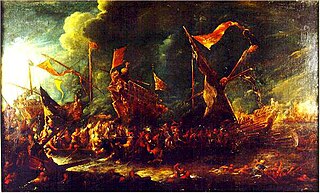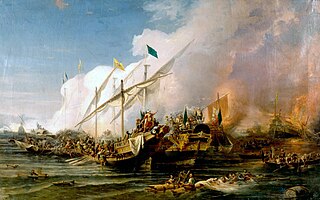 W
WThe 1541 Algiers expedition occurred when Charles V of the Holy Roman Empire attempted to lead an amphibious attack against the Ottoman Empire's stronghold of Algiers, in modern Algeria. Inadequate planning, particularly against unfavourable weather, led to the failure of the expedition.
 W
WThe battle of Alboran took place on 1 October 1540 off the isle of Alboran during the Ottoman-Habsburg struggle for the control of the Mediterranean when a Spanish fleet under the command of Bernardino de Mendoza destroyed an Ottoman fleet commanded by Ali Hamet, sinking a galley and capturing 10 other ships.
 W
WThe battle of Cape Celidonia took place on 14 July 1616 during the Ottoman-Habsburg struggle for the control of the Mediterranean when a small Spanish fleet under the command of Francisco de Rivera y Medina cruising off Cyprus was attacked by an Ottoman fleet that vastly outnumbered it. Despite this, the Spanish ships, mostly galleons, managed to repel the Ottomans, whose fleet consisted mainly of galleys, inflicting heavy losses.
 W
WThe Battle of Cape Corvo was a naval engagement of the Ottoman–Habsburg wars fought as part of the struggle for the control of the Mediterranean. It took place in August 1613 near the island of Samos when a Spanish squadron from Sicily, under Admiral Ottavio d'Aragona, engaged an Ottoman fleet led by Sinari Pasha. The Spanish were victorious and captured seven galleys and about 600 prisoners, among them the Bey of Alexandria and another 60 important Ottoman nobles. Cape Corvo was the first major victory of the Spanish fleets under Pedro Téllez-Girón, 3rd Duke of Osuna, the Spanish Viceroy of Sicily, as well as the greatest Spanish victory over the Ottoman Empire since the Battle of Lepanto.
 W
WThe Capture of Bougie occurred in 1555 when Salah Rais, the Ottoman ruler of Algiers, took the city of Béjaïa from the Spaniards. The main fortification in Bougie was the Spanish presidio, occupied by about 100 men under first under Luis Peralta, and then his son Alonso Peralta.
 W
WThe Conquest of Tunis in 1535 was a successful capture of Tunis, then under the control of the Ottoman Empire, by the Habsburg Empire of Charles V and its allies.
 W
WThe Conquest of Tunis in 1574 marked the final conquest of Tunis by the Ottoman Empire over the Spanish Empire. This was an event of great significance as it decided that North Africa would be under Muslim rather than Christian rule and ended the Spanish Conquista of Northern Africa, which started in 1497 under the Catholic Monarchs of Spain. The capture of Tunis in 1574 "sealed the Ottoman domination of the eastern and central Maghreb".
 W
WThe Battle of Djerba took place in May 1560 near the island of Djerba, Tunisia. The Ottomans under Piyale Pasha's command overwhelmed a large joint Christian Alliance fleet, composed chiefly of Spanish, Papal, Genoese, Maltese, and Neapolitan forces. The allies lost 27 galleys and some smaller vessels as well as the fortified island of Djerba. This victory marked perhaps the high point of Ottoman power in the Mediterranean Sea.
 W
WThe Expedition of Mostaganem occurred in 1558, when Spanish forces attempted to capture the city of Mostaganem, in modern Algeria, from the Ottomans. The expedition was supposed to be a decisive step in the conquest of the Ottoman base of Algiers, but it ended in failure, and has been called a "disaster".
 W
WThe Battle of Girolata was a naval action fought between Genoese, Spanish, and Ottoman ships on 15 June 1540 in the Gulf of Girolata, on the west coast of the island of Corsica, amidst the war between Charles V, Holy Roman Emperor and Suleiman the Magnificent. A Spanish squadron of 21 galleys led by the Genoese Gianettino Doria and the Spaniard Berenguer de Requesens surprised an Ottoman squadron of 11 galleys, anchored at Girolata, led by the Ottoman admiral Dragut, whom the commander of the Ottoman Navy, Hayreddin Barbarossa, had committed to raid the Italian coast after his victories in the Adriatic sea the year before. As the crews of the Ottoman warships were ashore, distributing the booty from recent raids, the Spanish-Genoese fleet easily overtook them, taking all 11 Ottoman galleys and making 1,200 prisoners, among them Dragut, who was carried to Genoa and put, together with his captains, to row in Andrea Doria's galleys.
 W
WThe Great Siege of Malta occurred in 1565 when the Ottoman Empire attempted to conquer the island of Malta, then held by the Knights Hospitaller. The siege lasted nearly four months, from 18 May to 11 September 1565.
 W
WThe Holy League of 1535 was as ad hoc coalition of catholic states arranged by Pope Paul III at the urging of Charles V.
 W
WThe capture of Mahdia was an amphibious military operation that took place from June to September, 1550, during the struggle between the Ottoman Empire and the Spanish Habsburgs for the control of the Mediterranean. A Spanish naval expedition under the command of the Genoese condottiero and admiral Andrea Doria and the Spaniard Bernardino de Mendoza, supported by the Knights of Malta under their Grand Master Claude de la Sengle, besieged and captured the Ottoman stronghold of Mahdia or Mahdiye, defended by the Ottoman Admiral Turgut Reis, known as Dragut, who was using the place as a base for his piratical activities throughout the Spanish and Italian coasts. Mahdia was abandoned by Spain three years later, and all its fortifications were demolished to avoid a re-occupation of the city by the Ottomans.
 W
WNasrid–Ottoman relations occurred during the last years of the 15th century, as the Nasrid dynasty attempted to obtain the help of the Ottoman Empire against the Reconquista in Spain.
 W
WBetween April and June 1563 the Regency of Algiers launched a major military campaign to retake the Spanish military-bases of Oran and Mers el Kébir on the North African coast, occupied by Spain since 1505. The sieges of Oran and Mers El Kébir of 1563 represented a major Hispano-Algerian episode in the larger Ottoman-Habsburg wars of the Mediterranean. The Kingdom of Algiers, the Principalities of Kabyle, and other vassal tribes combined forces as one army under Hasan Pasha, son of Hayreddin Barbarossa, and Jafar Catania. The Spanish commander brothers, Alonso de Córdoba Count of Alcaudete and Martín de Córdoba, managed to hold the strongholds of Oran and Mers El Kébir, respectively, until the relief fleet of Francisco de Mendoza arrived to successfully defeat the offensive.
 W
WThe Ottoman invasion of Otranto occurred between 1480 and 1481 at the Italian city of Otranto in Apulia, southern Italy. Forces of the Ottoman Empire invaded and laid siege to the city and its citadel. According to a traditional account, more than 800 inhabitants were beheaded after the city was captured. The Martyrs of Otranto are still celebrated in Italy. A year later the Ottoman garrison surrendered the city following a siege by Christian forces and the intervention of Papal forces led by the Genoese Paolo Fregoso.
 W
WAn Ottoman raid of the Balearic islands was accomplished by the Ottoman Empire in 1558, against the Spanish Habsburg territory of the Balearic islands.
 W
WThe Ottoman–Habsburg wars were fought from the 16th through the 18th centuries between the Ottoman Empire and the Habsburg Monarchy, which was at times supported by the Holy Roman Empire, Kingdom of Hungary, Polish–Lithuanian Commonwealth, and Habsburg Spain. The wars were dominated by land campaigns in Hungary, including Transylvania and Vojvodina, Croatia and central Serbia.
 W
WThe Second Ottoman–Venetian War was fought between the Islamic Ottoman Empire and the Republic of Venice for control of the lands that were contested between the two parties in the Aegean Sea, Ionian Sea, and the Adriatic Sea. The war lasted from 1499 to 1503.
 W
WThe Third Ottoman Venetian War (1537–1540) was one of the Ottoman–Venetian wars which took place during the 16th century. The war arose out of the Franco-Ottoman alliance between Francis I of France and Süleyman I of the Ottoman Empire against the Holy Roman Emperor Charles V. The initial plan between the two had been to jointly invade Italy, Francis through Lombardy in the North and Süleyman through Apulia to the South. However, the proposed invasion failed to take place.
 W
WThe Fourth Ottoman–Venetian War, also known as the War of Cyprus was fought between 1570 and 1573. It was waged between the Ottoman Empire and the Republic of Venice, the latter joined by the Holy League, a coalition of Christian states formed under the auspices of the Pope, which included Spain, the Republic of Genoa, the Duchy of Savoy, the Knights Hospitaller, the Grand Duchy of Tuscany, and other Italian states.
 W
WThe Battle of Preveza was a naval battle that took place on 28 September 1538 near Preveza in northwestern Greece between an Ottoman fleet and that of a Christian alliance assembled by Pope Paul III in which the Ottoman fleet defeated the allies. It occurred in the same area in the Ionian Sea as the Battle of Actium, 31 BC. It was one of the three largest sea battles that took place in the sixteenth century Mediterranean, along with the Battle of Djerba and the Battle of Lepanto.
 W
WThe Siege of Castelnuovo was an engagement during the Ottoman-Habsburg struggle for control of the Mediterranean, which took place in July 1539 at the walled town of Castelnuovo, present-day Herceg Novi, Montenegro. Castelnuovo had been conquered by elements of various Spanish tercios the year before during the failed campaign of the Holy League against the Ottoman Empire in Eastern Mediterranean waters. The walled town was besieged by land and sea by a powerful Ottoman army under Hayreddin Barbarossa, who offered an honourable surrender to the defenders. These terms were rejected by the Spanish commanding officer Francisco de Sarmiento and his captains even though they knew that the Holy League's fleet, defeated at the Battle of Preveza, could not relieve them. During the siege, Barbarossa's army suffered heavy losses due to the stubborn resistance of Sarmiento's men. However, Castelnuovo eventually fell into Ottoman hands and almost all the Spanish defenders, including Sarmiento, were killed. The loss of the town ended the Christian attempt to regain control of the Eastern Mediterranean. The courage displayed by the Old Tercio of Naples during this last stand, however, was praised and admired throughout Europe and was the subject of numerous poems and songs. Even the Venetian refused the promised naval link to Castelnuovo with the supplies and reinforcements; after a general troop parliament, the Capitan Francisco de Sarmiento answer to the Barbarossa surrender question was: "Que vengan cuando quieran".
 W
WThe Siege of Coron in 1532–1534 involved the siege and capture of the Ottoman-held fortress of Koroni (Coron) in Messenia, Greece, by the forces of the Habsburg Empire, and its subsequent recapture by the Ottomans.
 W
WThe Siege of Vienna, in 1529, was the first attempt by the Ottoman Empire to capture the city of Vienna, Austria. Suleiman the Magnificent, sultan of the Ottomans, attacked the city with over 100,000 men, while the defenders, led by Niklas Graf Salm, numbered no more than 21,000. Nevertheless, Vienna was able to survive the siege, which ultimately lasted just over two weeks, from 27 September to 15 October 1529.